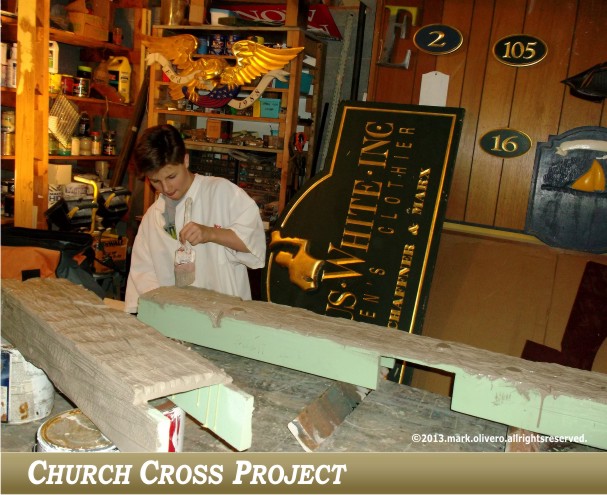 Georgia O’Keeffe said “Nothing is less real than realism. Details are confusing. It is only by selection, by elimination, by emphasis, that we get at the real meaning of things.” She was (and is) a famous artist. Her opinion is helpful even if you aren’t an artist.
Georgia O’Keeffe said “Nothing is less real than realism. Details are confusing. It is only by selection, by elimination, by emphasis, that we get at the real meaning of things.” She was (and is) a famous artist. Her opinion is helpful even if you aren’t an artist.
Did you ever read a book, hear a piece of music or look at a painting and think, “Too much, just too much.”
This project is one in which selection is necessary as the process evolves (although not Darwinian selection). What details to leave out? What details to accentuate?
When I sketched the cross in the beginning I had an idea that 3 nails would be a good detail. As I pondered it and talked about it with others the detail of nails slid into the column of “too much.”
Remnants of rope as they might have been used in a crucifixion was a detail that stayed.*
*Thank you JMG Ranch for providing the rope.
.
However, the idea of nails is not left out altogether. The detail of nail holes randomly struck in the beam gives the suggestion of the cross having been used several times before. It is likely that the Romans would reuse their crosses. I doubt that the authorities thought this man from Nazareth needed a special cross since he would one day become famous. He was condemned as a criminal like thousands of others. No special treatment.
But this criminal was not merely “not guilty.” He was innocent. In the horror his beauty shines. Innocence gazes on us ever so pure, so holy, when around it the darkened sky of evil swirls. The many nail holes remind us that he was “numbered with the transgressors” (see Isaiah 53:12esv).
Then there are details that most people will not notice because those details blend with the whole. In this step I add more spots of glaze or color as needed. It helps to look at the assembled piece in different lighting. I set it up in the shop, later outside in the sun light and still later in the church a couple of weeks before the installation.
Fitting the cross together in the shop helps to get a sense of what needs adjusting. Black is not a color most artists use well. When black is needed I prefer to mix a pseudo-black from other colors. However, in a few small places I add a little true black. Some of the crevices needed a little depth from a dab of black.
Another detail is to “grey out” some of the edges. This gives the sense that those places have been bleached by extended exposure to the sun. But here again, I only do this to the slightest degree since too much would be too much.
Finally a small detail, but a useful one that fills out the visual narrative is the foot hold. I want it to appear tacked on as an after thought. It is possible that these foot holds had to be replaced from time to time. Even though a cross was still usable a foot hold might swing loose with repeated nailings or weight stresses.
Interesting though they be these details are not things to be admired. The cross is a disgusting thing. We admire the Cross because of Christ. Like a diamond the cross is the setting in which the jewel sits. The Christ of the Cross is our anthem. We cherish the Stone that the builders discarded. We love him who, as Isaiah wrote, “was wounded for our transgressions.”














 As I mentioned in
As I mentioned in

 If not the most important symbol in Christianity certainly the cross has to rank in the top 5. Whether to have a cross or not in the church is for some groups a topic of debate. If so, then what kind of cross is best?
If not the most important symbol in Christianity certainly the cross has to rank in the top 5. Whether to have a cross or not in the church is for some groups a topic of debate. If so, then what kind of cross is best?